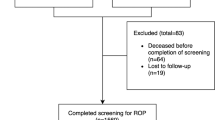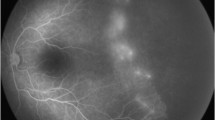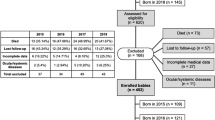Abstract
Background
The incidence of retinopathy of prematurity (ROP) and ROP screening criteria differ between countries. We assessed whether ROP screening could be reduced based on the local ROP incidence.
Methods
Observational cohort study of infants born in Switzerland between 2006 and 2015 <32 0/7 weeks. Chronological and postmenstrual ages at ROP treatment were analyzed. A model to identify ROP treatment on patients born between 2006 and 2012 (training set) was developed and tested on patients born between 2013 and 2015 (validation set).
Results
Of 7817 live-born infants, 1098 died within the first 5 weeks of life. The remaining 6719 infants were included into analysis. All patients requiring ROP treatment would have been identified if screening had been performed before reaching 60 days of life or 37 3/7 weeks postmenstrual age, whichever came first. The training and validation sets included 4522 and 2197 preterm infants encompassing 56 and 20 patients receiving ROP treatment, respectively. All patients would have required screening to reach 100% sensitivity. To reach a sensitivity of 95.0% and a specificity of 87.6%, we predicted a reduction in 13.2% of patients requiring screening (c-statistic = 0.916).
Conclusions
A substantial reduction of infants requiring screening seems possible, but necessitates prospective testing of new screening criteria.
Similar content being viewed by others
Log in or create a free account to read this content
Gain free access to this article, as well as selected content from this journal and more on nature.com
or
References
Hartnett, M. E. & Penn, J. S. Mechanisms and management of retinopathy of prematurity. N. Engl. J. Med. 367, 2515–2526 (2012).
Hartnett, M. E. Pathophysiology and mechanisms of severe retinopathy of prematurity. Ophthalmology 122, 200–210 (2015).
Slidsborg, C. et al. A new risk-based screening criterion for treatment-demanding retinopathy of prematurity in Denmark. Pediatrics 127, e598–e606 (2011).
Darlow B. A. et al. International variations and trends in the treatment for retinopathy of prematurity. Br. J. Ophthalmol. 101, 1399–1404 (2017).
Grupo de Trabajo Colaborativo Multicentrico para la Prevencion de la Ceguera en la Infancia por Retinopatia del P. Recommendations for retinopathy of prematurity screening in at-risk populations. Arch. Argent. Pediatr. 106, 71–76 (2008).
Zin, A. et al. Brazilian guidelines proposal for screening and treatment of retinopathy of prematurity (ROP). Arq. Bras. Oftalmol. 70, 875–883 (2007).
Jefferies, A. L., Canadian Paediatric Society F. & Newborn, C. Retinopathy of prematurity: an update on screening and management. Paediatr. Child Health 21, 101–108 (2016).
Fierson, W. M., American Academy of Pediatrics Section on O., American Academy of O., American Association for Pediatric O., Strabismus, American Association of Certified O. Screening examination of premature infants for retinopathy of prematurity. Pediatrics 131, 189–195 (2013).
Li, Q. et al. A prospective study of the incidence of retinopathy of prematurity in China: evaluation of different screening criteria. J. Ophthalmol. 2016, 5918736 (2016).
Roohipoor, R. et al. Retinopathy of prematurity screening criteria in Iran: new screening guidelines. Arch. Dis. Child Fetal Neonatal Ed. 101, F288–F293 (2016).
Gerull R. et al. Incidence of retinopathy of prematurity (ROP) and ROP treatment in Switzerland 2006–2015: a population-based analysis. Arch. Dis. Child Fetal Neonatal Ed. 103, F337–F342 (2018).
International Committee for the Classification of Retinopathy of P. The International Classification of Retinopathy of Prematurity revisited. Arch. Ophthalmol. 123, 991–999 (2005).
Voigt, M. et al. New percentile values for the anthropometric dimensions of singleton neonates: analysis of perinatal survey data of 2007–2011 from all 16 states of Germany. Z. Geburtshilfe Neonatol. 218, 210–217 (2014).
Jobe, A. H. & Bancalari, E. Bronchopulmonary dysplasia. Am. J. Respir. Crit. Care Med. 163, 1723–1729 (2001).
Bell, M. J. et al. Neonatal necrotizing enterocolitis. Therapeutic decisions based upon clinical staging. Ann. Surg. 187, 1–7 (1978).
Papile, L. A., Burstein, J., Burstein, R. & Koffler, H. Incidence and evolution of subependymal and intraventricular hemorrhage: a study of infants with birth weights less than 1,500 gm. J. Pediatr. 92, 529–534 (1978).
van Buuren, S. G.-O. K. Multivariate imputation by chained equations in R. J. Stat. Softw. 45, 1–67 (2011).
Wilson, C. M., Ells, A. L. & Fielder, A. R. The challenge of screening for retinopathy of prematurity. Clin. Perinatol. 40, 241–259 (2013).
Wilkinson, A. R., Haines, L., Head, K. & Fielder, A. R. UK retinopathy of prematurity guideline. Early Hum. Dev. 84, 71–74 (2008).
Nowicki, M., Ostalska-Nowicka, D., Kaczmarek, M., Miskowiak, B. & Witt, M. The significance of VEGF-C/VEGFR-2 interaction in the neovascularization and prognosis of nephroblastoma (Wilms’ tumour). Histopathology 50, 358–364 (2007).
Hutchinson, A. K. et al. Clinical models and algorithms for the prediction of retinopathy of prematurity: a report by the American Academy of Ophthalmology. Ophthalmology 123, 804–816 (2016).
Hellstrom, A. et al. Early weight gain predicts retinopathy in preterm infants: new, simple, efficient approach to screening. Pediatrics 123, e638–e645 (2009).
Lofqvist, C. et al. Longitudinal postnatal weight and insulin-like growth factor I measurements in the prediction of retinopathy of prematurity. Arch. Ophthalmol. 124, 1711–1718 (2006).
Eriksson, L., Liden, U., Lofqvist, C. & Hellstrom, A. WINROP can modify ROP screening praxis: a validation of WINROP in populations in Sormland and Vastmanland. Br. J. Ophthalmol. 98, 964–966 (2014).
Lundgren, P. et al. WINROP identifies severe retinopathy of prematurity at an early stage in a nation-based cohort of extremely preterm infants. PLoS ONE 8, e73256 (2013).
Choi, J. H., Lofqvist, C., Hellstrom, A. & Heo, H. Efficacy of the screening algorithm WINROP in a Korean population of preterm infants. JAMA Ophthalmol. 131, 62–66 (2013).
Sun, H. et al. The use of the WINROP screening algorithm for the prediction of retinopathy of prematurity in a Chinese population. Neonatology 104, 127–132 (2013).
Piyasena, C. et al. Prediction of severe retinopathy of prematurity using the WINROP algorithm in a birth cohort in South East Scotland. Arch. Dis. Child Fetal Neonatal Ed. 99, F29–F33 (2014).
Good, W. V., Early Treatment for Retinopathy of Prematurity Cooperative G. Final results of the Early Treatment for Retinopathy of Prematurity (ETROP) randomized trial. Trans. Am. Ophthalmol. Soc. 102, 233–248 (2004). discussion 248–250.
Acknowledgements
We would like to thank Karine Landgren-Hugentobler for proofreading and editing of the manuscript.
We also thank the following units for collaborating in this study of the SwissNeoNet
Aarau: Ph. Meyer9, C. Anderegg9, A. Capone Mori10, D. Kaeppeli10, S. Schulzke11, P. Weber12, G.P. Ramelli13, M. Nelle14, B. Wagner15, M. Steinlin16, S. Grunt16, R. Hassink17, T. Riedel18, E. Keller19, Ch. Killer19, K. Fuhrer20, J.-F. Tolsa21, M. Roth-Kleiner21, M. Bickle-Graz22, R. E. Pfister23, P. S. Huppi24, C. Borradori-Tolsa24, M. Stocker25, T. Schmitt-Mechelke26, F. Bauder26, V. Pezzoli27, B. Erkert28, A. Mueller28, M. Ecoffey29, A. Malzacher30, J. P. Micallef31, A. Lang-Dullenkopf32, L. Hegi33, M. von Rhein34, D. Bassler35, R. Arlettaz35, V. Bernet36, B. Latal37, G. Natalucci37
Funding
The authors have no financial relationships relevant to this article to disclose.
Author information
Authors and Affiliations
Consortia
Corresponding author
Ethics declarations
Competing interest
The authors declare no competing interests.
Additional information
Publisher's note: Springer Nature remains neutral with regard to jurisdictional claims in published maps and institutional affiliations.
Rights and permissions
About this article
Cite this article
Gerull, R., Brauer, V., Bassler, D. et al. Prediction of ROP Treatment and Evaluation of Screening Criteria in VLBW Infants–a Population Based Analysis. Pediatr Res 84, 632–638 (2018). https://doi.org/10.1038/s41390-018-0128-3
Received:
Revised:
Accepted:
Published:
Issue date:
DOI: https://doi.org/10.1038/s41390-018-0128-3
This article is cited by
-
Vasoactive peptides as biomarkers for the prediction of retinopathy of prematurity
Pediatric Research (2024)
-
Early prediction of severe retinopathy of prematurity requiring laser treatment using physiological data
Pediatric Research (2023)
-
Retrospective validation of the postnatal Growth and Retinopathy of Prematurity (G-ROP) criteria in a Swiss cohort
BMC Ophthalmology (2022)
-
Risk of development of treated retinopathy of prematurity in very low birth weight infants
Journal of Perinatology (2019)



